Transportation In Animals And Plants Worksheet
Objective Type Questions
- Identify the component of blood based on the clues provided.
(a) I appear in the form of fragments. I help in clotting of blood in case of an injury. Who am I?
(b) I am red in colour. I carry oxygen from the lungs to all the cells of the body. Who am I?
(c) I am pale yellow and sticky liquid. I carry water and dissolved substances from one part of the body to the other. Who am I?
(d) I am colourless. I fight infections and protect the body from diseases. Who am I? - The diagram below shows the human heart. Label the parts A, B, C, D, E, F and G correctly choosing the appropriate terms from those given in the brackets.
(right ventricle, left auricle, aorta, left ventricle, pulmonary veins, right auricle, pulmonary artery)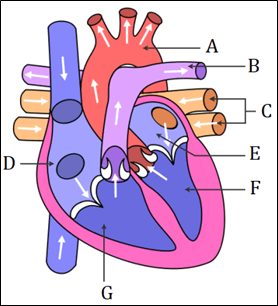
- Match the terms in column A with appropriate terms in column B.
Multiple Choice Questions - Hormones are substances produced by the glands of the human body. These need to be transported to the cells present throughout the body. The function of transportation of hormones is carried out by the
(a) Digestive system
(b) Excretory system
(c) Integumentary system
(d) Circulatory system - Kiya read about various systems of the human body and claimed that the digestive system alone can pass nutrients to every cell of the body. Is the claim made by Kiya, correct?
(a) Yes, the stomach is a component of the digestive system which helps in the delivery of nutrients to all the body cells.
(b) Yes, the small intestine is a component of the digestive system which absorbs the nutrients from the food and delivers it to all the cells.
(c) No, the digestive system passes nutrients into the blood, which is then delivered to the body cells through the circulatory system.
(d) No, the heart is a component of the circulatory system, which directly absorbs nutrients. - Aruna was facing difficulty in breathing. On diagnosis, the doctor confirmed that the haemoglobin content in Aruna’s body was less than the normal range. What role does haemoglobin play in breathing?
(a) It helps in the transportation of oxygen to all the body cells.
(b) It prevents clot formation inside the respiratory tract.
(c) It helps the lungs to take in more air from the surroundings.
(d) It fights against germs that enter the respiratory tract. - The below chart lists some characteristic features of a blood vessel.
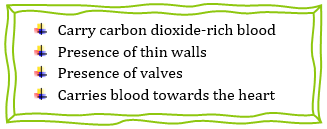
Which of the following will have all these characteristics features?
(a) Only pulmonary vein
(b) Only pulmonary artery
(c) All veins except the pulmonary vein
(d) All arteries except the pulmonary artery - The table shows the number of pulse beats counted by Ramesh and Suresh respectively for 2 minutes.
What is likely to be concluded from the above observation?
(a) The pulse rate of Ramesh is higher than the normal pulse rate.
(b) The pulse rate of Suresh is lower than the normal pulse rate.
(c) The pulse rate of Ramesh and Suresh is equivalent to the normal pulse rate.
(d) The pulse rate of both Ramesh and Suresh is higher than the normal pulse rate. - People use water pumps in their houses to circulate water in the house pipes. If our blood vessels are compared to water pipes and blood to water, then which organ of the human body acts as a water pump and circulates blood throughout the body?
(a) Heart
(b) Lungs
(c) Liver
(d) Kidney - Riddhi was provided with a three-dimensional model of human circulatory system. The teacher asked her to identify the position of heart in the model. Where should Riddhi locate the heart in the circulatory system?
(a) A structure that is located in the chest cavity with its lower tip slightly tilted towards the left.
(b) A structure that is located in the chest cavity with its upper tip slightly tilted towards the left.
(c) A structure that is located in the abdominal cavity with its lower tip slightly tilted towards the right.
(d) A structure that is located in the abdominal cavity with its upper tip slightly tilted towards the left. - The image shows an unlabelled sketch of the human excretory system. Identify the label in the image which represents the structure that helps to store urine.
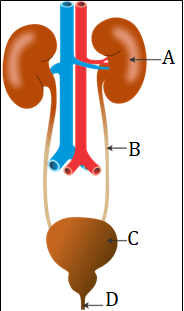
(a) A
(b) B
(c) C
(d) D - The table lists the excretory substances of fishes, snakes, and humans. Which factor is responsible for this difference in the excretory products of these organisms?

(a) Availability of water
(b) Availability of nutrients
(c) Availability of oxygen
(d) Availability of optimum temperature - Plants absorb water from the soil to prepare their own food. Which of the following factors will decrease the absorption of water by the plants?
(a) Decrease in soil temperature
(b) Decrease in the rate of transpiration
(c) Increase in the number of root hairs
(d) Decrease in the amount of water in the soil - The generation of suction pull in plants plays an important role in moving minerals and water from the roots to other parts of the plants. The generation of suction pull takes place due to the evaporation of water from the leaves. Which of the following factors will favour the rapid transport of materials in plants?
(a) Absence of air currents
(b) Increased relative humidity
(c) Less absorption of water from the soil
(d) Increase in environmental temperature - Which of the following does NOT relate to the regular need for blood donation?
(a) Blood has a limited shelf life.
(b) Every 2 seconds someone needs blood.
(c) It improves the blood circulation of the donor.
(d) Blood cannot be manufactured outside the body.
Subjective Questions - Anuja observed the cross-section of two blood vessels, A and B with the help of a microscope. The table lists the observations made by her.
(a) Identify A and B.
(b) What conclusion can be made about the type of blood carried by blood vessels A and B? - Kanika placed the index finger of her right hand on the inner side of her left wrist. She felt some throbbing movements.
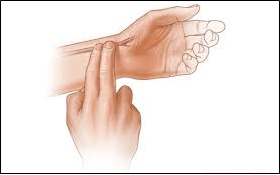
(a) What terminology can be used for these movements?
(b) Why does one feel the throbbing movements?
(c) Define pulse rate.
(d) What is the pulse rate of an adult person at rest? - The human heart is divided into four chambers. A partition separates these chambers from each other.
(a) Name the four chambers of the heart.
(b) Why is the partition between these chambers necessary? - Observe the figure below and answer the following questions.
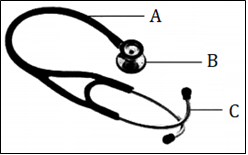
(a) Name the instrument.
(b) What is the use of this instrument?
(c) Label parts A, B and C.
(d) Define heartbeat. - What will happen if both the kidneys of a person are damaged? What will you suggest helping the person to survive?
- How does water move up in tall trees?
Case-Based Questions - Blood is a fluid which flows in blood vessels. It transports substances like digested food from the small intestine to the other parts of the body. It carries oxygen from the lungs to the cells of the body. It also transports wastes for removal from the body.
a) Our body needs a continuous supply of food, water, and oxygen for its survival. These materials must reach the various parts of the body where they are needed. Which life process helps the cell to perform this function?
(a) Reproduction
(b) Transportation
(c) Cellular respiration
(d) Excretion
b) Find the odd one out:
Heart, Blood, Arteries, Lungs
c) Blood consists of four components: ……………….., red blood cells, white blood cells and platelets. - Plants absorb water and minerals through root hairs. The root hair is in contact with the water present between the soil particles. Plants have pipe-like vessels to transport water and nutrients from the soil.
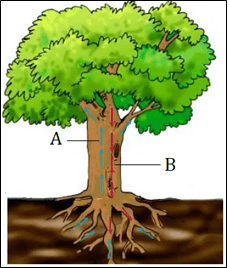
(a) Identify A and B.
(b) What are the functions of A and B?
(c) The pipe-like vessels in plants which transport water and nutrients are made of special cells forming the ……………….. tissue.
(d) What is the role of root hair?
Assertion-Reasoning Questions
Below questions consist of two statements – Assertion (A) and Reason (R). Answer these questions selecting the appropriate option given below:
- Assertion (A): The average heartbeat of an adult person at rest is 72 to 80 beats per minute.
Reason (R): Each heartbeat generates one pulse in the arteries and the pulse rate per minute indicates the rate of heartbeat. - Assertion (A): Animals such as sponges, and Hydra do not possess any circulatory system.
Reason (R): Entry of food and oxygen and removal of wastes occurs through the water in which they live.
Explore more Science Sample papers and Solutions
-
Sample Papers for CBSE Class 7 Science Term 1 #1
-
Sample Papers for CBSE Class 7 Science Term 2 #1
-
Nutrition in Plants Worksheet
- Nutrition in Animals Worksheets
- Heat Worksheet
- Acids, Bases And Salts Worksheet
- Physical And Chemical Changes Worksheet
- Respiration in Organisms Worksheet
- Reproduction in Plants Worksheet
- Motion And Time Worksheet
- Electric Current And Its Effects Worksheet
- Light Worksheet
- Forests: Our Lifeline Worksheet
- Wastewater Story Worksheet
- Competency Based Questions for CBSE Class 7 Science
- Sample Papers for CBSE Class 7 Science Term 1 #2
- Sample Papers for CBSE Class 7 Science Term 2 #2
Key Features of Study Materials of CBSE Class 7 Science:
- Easiest and most comprehensive study materials
- Designed by subject matter experts
- Revised according to the latest CBSE syllabus
- Helpful for quick revision
- ‘Ask a Doubt’ facility
- Significant improvement in marks



